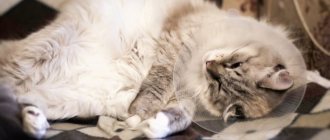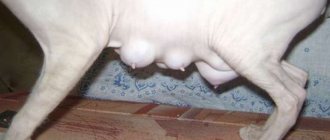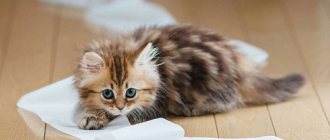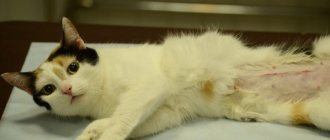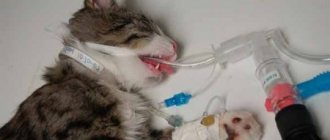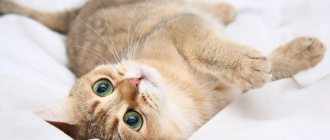Castration of males is a fairly simple surgical procedure, but it is still an operation after which animals need systematic special care, attention and care, especially the first five to seven days. How quickly the recovery period will pass largely depends on the correct actions of the owners. After surgery, monitor your pet’s behavior and health, and monitor the condition of postoperative wounds.
Post-castration wounds are small and heal quite quickly, but a cat licking them can cause an infection . Your pet's saliva contains bacteria that can cause acute inflammation, swelling, and can cause other serious complications. But if it so happens that the cat licked the wound after castration, let’s consider what to do in this situation.
Some information about the operation
Of course, the process of sterilization itself, that is, removal of reproductive organs, is not necessary for ordinary people to know.
It is important to understand that such an operation is necessary if you do not want to breed kittens. There are two types of cat sterilization:
- ovariohysterectomy: during the operation, all reproductive organs (ovaries and uterus) are removed;
- oophorectomy: the most common method, which involves removing only the ovaries. This type of sterilization is somewhat more dangerous than the previous one, since the non-functioning uterus remaining in the abdominal cavity can become inflamed and cause a new operation.
https://www.youtube.com/watch?v=upload
Veterinarians also use different methods for sterilizing cats, depending on the skill of the doctor, equipment and cost of the procedure:
- A classic option that has been successfully used for many years. The veterinarian makes an incision along the linea alba and removes the reproductive organs. The advantages of this method include its relative ease of execution, low cost of the operation, and the disadvantages are quite large, compared to others, damage to the body.
- Safer is sterilization using a side incision, which is much smaller than the classic one and causes less damage to the body. The abdominal muscles are dissected (that is, pulled apart and clamped with a blunt instrument) rather than cut with a scalpel.
- The most advanced and most expensive method of sterilization is laparoscopy. A small puncture is made in the abdominal wall through which the device is inserted. The uterus and ovaries are safely removed through electronic monitoring. There are practically no stitches, and the animal does not require postoperative care.
When taking your pet home after surgery, place it in a carrier with soft, warm towels. The animal's body temperature may drop slightly.
Constipation in a cat after sterilization: what to do, why it occurs
Complications after cat sterilization surgery are the worst thing pet owners can imagine. One wrong movement of the animal itself or the slightest accident can lead to the most unpleasant consequences.
Various complications: gnawing on stitches, bruise, suppuration, inflammation - will lead to the need for new medical intervention.
You can understand this by the cat’s behavior: after three or four days it hurts to lie on its tummy, it constantly worries, meows, and refuses to eat. If you notice this, call your veterinarian immediately.
It is very important to ensure the sterility of the suture after surgery. Dirt that gets on it can lead to rotting. To prevent this, a blanket is put on the animal, but cats like to take it off.
If there is severe tissue necrosis, you will have to repeat the operation and apply new sutures.
Many owners are concerned about the lump that appears on the abdomen. What people mistake for pathology is actually a feature of cat tissue repair.
The lump consists of overgrown young connective (or granulation) tissue. Literally a month after the operation, it will gradually stretch and disappear.
If this is your first time dealing with sterilization of a cat, you should carefully listen to the advice of veterinarians about keeping your pet after surgery, about the diet for the first days, and about whether to give vitamins.
It is extremely rare, but it also happens that the seam comes apart after sterilization. What to do in this case? Be sure to go to the vet immediately. After all, the places where the seam has come apart are open to infection. And this threatens the pet with repeated surgery and possibly complications. At the appointment, the doctor will clean the wound, treat it and possibly prescribe antibiotics.
I always warn my patients: after sterilization, the cat should pee regularly, but at first there may be no stool. If after 3 days the pet does not go to the toilet in a big way, you need to take action.
https://www.youtube.com/watch?v=ytcopyrightru
There are several reasons for intestinal dysfunction. Firstly, this is a long-term starvation diet. Before anesthesia, you can feed the cat 10-12 hours. But if the operation is scheduled for the middle of the day, owners can increase this interval (do not feed the cat in the middle of the night!). Plus, the cat does not receive food for some time after the operation. As a result, she simply has nothing to poop with; it takes time for feces to form.
The second reason is the effect of drugs that are used for anesthesia in cats. Agents for intramuscular anesthesia (Domitor, Rometar, xylazine) not only significantly reduce body temperature in animals, but also affect the motility of the digestive tract. Because of this, intestinal peristalsis on the first day after surgery may be sluggish, and vomiting is possible.
The third reason for constipation after sterilization is simple stress associated with a trip to the clinic, surgery and wearing a blanket. Clothes can irritate your cat and make it difficult for you to get comfortable in the litter box.
If on the 3-4th day after the operation there is no long-awaited pile in the tray, you need to give the cat a mild laxative. It could be:
- A teaspoon of petroleum jelly (about 3 ml)
- A tablespoon of condensed milk half and half with water.
Vaseline oil is given twice a day until the cat has a bowel movement. This is liquid paraffin, the product has no taste or smell, and most importantly, it is not absorbed at all in the digestive tract. It is sold in human pharmacies, no other oil is suitable!
A tiny cosmetic stitch after sterilization of a cat normally heals quickly without a trace. However, this is not always the case. Sometimes owners are forced to return to the clinic again because the cat’s stitch has come apart after sterilization.
The most common cause of this problem is neglect of the veterinarian's recommendations. If after surgery the cat does not wear a collar or blanket, it will tend to lick the stitches.
Together with saliva, an infection enters the wound, and severe inflammation (festering) of the suture occurs. In this case, no threads will hold the fabric together. In addition, with its rough tongue, a cat can get rid of stitches ahead of time.
If the suture discrepancy is minor, the doctor may prescribe “conservative” treatment. First of all, you need to stop the seam from licking. Then local blockades are made (Novocaine 0.5% with an antibiotic), the wound is washed 1-2 times a day. Sometimes healing ointments and preparations such as Vinilin are used. Treatments sometimes last a long time, 1-2 weeks, so I urge owners to take care of the suture immediately after surgery to avoid such problems.
Minor divergence of the cosmetic seam (the cat was not wearing a blanket)
The cat was sterilized in a third-party clinic, the external and internal seams were made with silk, the cat did not wear a blanket
Severe seam divergence, 3 weeks have passed since sterilization
All non-viable tissue was removed and sutures were re-sutured.
The same cat after removal of stitches (12 days after wound revision)
General recommendations
The owner needs to remember a number of important nuances. Analgesics must be used in the first three days before treatment. At this time, the cat will painfully perceive any mechanical impact on the seam. The animal may resist, scratch, and in the most severe cases, painful shock is possible.
Under no circumstances use paracetamol or other medicines from your home medicine cabinet for these purposes! “Human” anesthetics are in many cases deadly for cats.
We strongly do not recommend removing the surgical collar (if any) from the cat during treatment! Without it, the cat may bite the owner, especially in the first days after surgery, when the suture can cause the animal a lot of discomfort.
The first treatment should be carried out on the second day after surgery. There's no point in doing it earlier!
Finally, the frequency of processing. It is believed that this should be done no more than twice a day. If the seam heals well and does not ooze ichor, you can disinfect it every two days (remember to consult a veterinarian first).
How to care for a cat after sterilization
Of course, your operating doctor will tell you about all the nuances and subtleties of care. But every owner of his pet wants to be prepared in advance and know what needs to be done after surgery to help his pet.
There are some differences in cat care depending on the anesthesia used. After administering a certain type of anesthesia, you cannot feed the animal until 12 hours after the operation. This is due to possible problems with swallowing.
Typically, the cat owner is offered two options:
- Take the animal home and care for it yourself.
- Leave the cat in the veterinary clinic for a day after the operation.
- Leave the pet in a hospital setting for 7-10 days, during which time complete recovery and healing of the sutures usually occurs.
Trichobezoars: ingesting their own hair
For 7-14 days, depending on the doctor’s recommendation, the cat walks in a blanket or collar after sterilization. This is necessary so that she does not lick the seam. But as a result, the cat is deprived of the opportunity to wash its entire body and tidy its fur.
After the blanket is removed, the cat begins to lick itself furiously. All this time the wool fell out, became tangled under the blanket, but was not renewed. As a result, the animal swallows a huge amount of its own fur. Of course, if you have a Sphynx or Cornish Rex, there is nothing to worry about. And if the cat is a long-haired breed (Maine Coon), it must be combed with a furminator after you take off its clothes.
Trichobezoars, hairballs, are manifested either by periodic regurgitation (vomiting) or by the same constipation (see point No. 1).
How to care for a cat after sterilization at home
After the operation, the veterinarian places stitches on the inner wall of the abdomen and on the skin. The amount of care for the cat depends on what threads the doctor used when completing sterilization of the cat.
We suggest you familiarize yourself with How to inject Gamavit into a cat? — Zhivomag
Surgical sutures can dissolve after a certain time. They are quite convenient to use. The hidden seam does not require special care. The owners will not have to go to the clinic again to remove them.
Ordinary threads are a cheaper and more common material for safely closing a wound. After seven to ten days, such stitches must be removed either independently using nail scissors, or contact the same clinic.
It is very important not to delay this: the threads can “grow” into the skin of the cat’s abdomen, causing severe discomfort.
The treatment of the suture depends on the method of operation. In a veterinary clinic, the incision site is usually smeared with iodine for disinfection.
To prevent contamination of the seam, the cat is put on a special protective blanket, which can be purchased at a pet store, clinic, or sewn yourself. After this, you can leave the pet alone until the threads are removed.
https://www.youtube.com/watch?v=ytcreatorsru
A not so safe way to protect the seam is to preserve it. For example, Aluminum spray applied to the surgical site protects it from germs and bacteria. For prevention, the seam can sometimes be wiped with alcohol.
After surgery, cats become very weak. They need careful care, especially if the pet that returns home is under anesthesia.
Removing stitches for a cat after sterilization
If the healing process proceeds normally, the sutures should be removed after sterilization of the cat 7-10 days after the manipulation. This applies to surgical intervention performed by dissecting tissue along the white line of the abdomen.
If sterilization was carried out through a side incision, then cosmetic sutures are applied that do not need to be removed. Typically, after a cat is spayed, the suture heals within 10 days.
Complete tissue restoration depends on the type of surgery and suturing method. The healing process is always accompanied by itching in the pet, so it is necessary to take care of a special protective blanket that will help prevent licking or infection of the wound surface.
After time, the owner of the animal, with normal healing of the postoperative suture, can independently remove the sutures.
It is important to remember that only the suture material that is visible on the surface of the skin must be removed. It is strictly prohibited to get into the wound and remove internal stitches from a cat after sterilization. It is better, of course, to go to a veterinary clinic, since they will be able to properly fix the animal, assess the state of healing of the suture and remove the suture material.
Pulmonary edema in a cat after sterilization
Long gone are the days when pets were anesthetized “by eye,” and the owners begged the doctor “not to overdo it.” Now veterinary clinics have modern and safe means of anesthesia. Large clinics use inhalation anesthesia and epidural anesthesia. Despite this, general anesthesia can cause dangerous complications in cats after sterilization.
If your cat has problems with the heart muscle (hypertrophic cardiomyopathy, congenital defects), pulmonary edema or thromboembolism may develop after surgery. Both complications can lead to the death of the animal, even if the owner notices something is wrong in a timely manner and consults a doctor.
Scottish Fold ECHO of the heart is a must
Owners should monitor their cat for at least two weeks after sterilization. The pet should eat, drink, and play as usual within 24 hours. If a cat refuses to eat, lies in one place, breathes with its mouth open like a dog, you should immediately contact a well-equipped clinic for diagnosis.
Symptoms of a seam coming apart
Dehiscence can occur before the sutures are removed, if the external method was used, and after removal.
Suture dehiscence in a cat.
Cat pain
The main sign before the threads are removed will be the appearance of pain in the pet . The pain can be so sharp that the pet will show severe anxiety, meow loudly and pitifully, and break free from the owner’s hands.
The manifestation of pain in a cat is the main sign of suture dehiscence.
Redness of the incision site
Redness of the incision site after surgery is a symptom that the suture may come apart.
The next symptom is redness of the incision site, and possible swelling of the surrounding tissues. When palpated, the skin will be hot. The edges of the section may move away from each other, and bloody fluid, the so-called ichor, may be released. A dangerous symptom will be the release of pus through the edges of the wound. This phenomenon may indicate a strong inflammatory process.
The cat licked the seam
If a cat's blanket is removed, it may lick the seam.
If a cat's blanket is removed, it may lick the seam. It's instinct. It is necessary to monitor the quality of the blanket tightening and prevent it from loosening.
Rejection of suture material
Sometimes a cat's stitch may come apart after sterilization, even if she did not lick the wound. If non-sterile suture material was used during the operation, and the rules of asepsis and antisepsis were not followed, the wound may become infected.
Most often, a negative reaction occurs to non-absorbable threads (silk), too thick, coarse threads. Sometimes it is enough to remove the nodule from the wound for the reaction to stop.
If there are problems with the seam, owners notice that the cat's blanket gets wet. Or some stains or smudges appear on it. After sterilization, the seam should be clean and dry, and the skin in the wound area should be tightly closed joint to joint. If you see swelling, redness or discharge (usually this is not pus, but something like ichor) in the suture area, immediately show your pet to the surgeon. Treatment of the problem is the same as if a cat licked a seam.
Rarely, cats have a true reaction to suture material (rejection). In this case, you need to use threads made of a different material or even a special metal wire, which is removed after the tissue has healed.
Cause of seam divergence
Let's consider whether the threads can separate if the operation was performed by a qualified specialist. Despite the professionalism of the doctor, there may be a discrepancy in the section site for a number of reasons:
- Failure to comply with asepsis rules can result in infection in the wound.
- Great pressure on the operated area due to careless handling of the pet or too tight a bandage.
- The presence of diseases in the animal’s body that cause weakening of the muscles and soft tissues in the wound area.
- Excessively tight seam stitches and violation of the section closure technique.
- Long-term use of corticosteroid drugs before surgery.
- Hypovitaminosis, vitamin deficiency and other manifestations of a weakened body caused by a lack of microelements and vitamins.
If a suture comes apart after sterilization in a cat, the following additional factors can provoke it:
- unbalanced diet;
- obesity;
- diabetes;
- malignant formations;
- cough;
- kidney diseases.
Rules for rehabilitation after sterilization
After sterilization of the cat, during the normal healing process, the sutures are removed on days 10-14. Until this time, the pet requires careful care. The rules differ slightly depending on the options for the post-rehabilitation period. The veterinary clinic offers several such options:
- the owner takes the animal home immediately after sterilization and carries out the necessary manipulations there;
- the cat remains in the veterinary clinic for a day;
- the pet remains in the hospital for a period of about 10 days to fully recover after the operation.
Of course, it is more convenient for the owner and safer for the animal when the postoperative period takes place under the supervision of a veterinarian in the clinic. If you decide to pick up your cat right away, you will need a spacious carrier with a hard floor. It is better to have one with an open top so that the pet can be carefully placed instead of being pushed inside.
At home, it is necessary to provide the animal with complete peace in a secluded, safe place. After anesthesia, the body temperature usually drops, and the cat may freeze. In this case, it must be covered. Be sure to put water nearby. Until the cat recovers from anesthesia, it should be turned from side to side. And just as often, close your eyelids to prevent the cornea from drying out, since cats have open eyelids during anesthesia (this is their feature).
When the cat begins to recover from anesthesia, you should take care of its safety - close balconies, vents, windows, because behavior may be inappropriate. How the pet will behave depends on its character traits - some may bite and behave aggressively, while others may hardly move and sleep most of the time.
During this period, you should carefully monitor the animal and prevent it from harming itself. The blanket should not be removed under any circumstances to prevent licking of the seam! The cat will be able to move normally after some time (from 4 to 12 hours). It is necessary to give water on the first day after surgery; feeding can be postponed, especially if after trying to eat the pet starts vomiting.
In the first three days after surgery, the cat is given antibiotics and painkillers. After stopping pain medications, behavior may change due to pain in the suture area. If it is too strong, the animal may lie motionless, moan, behave aggressively, and the pupils may be dilated. In this case, the help of a veterinarian is urgently needed.
Throughout the postoperative period, you need to monitor the blanket - how it is tied, whether it is clean or not. It is important to adjust your diet and monitor your drinking regime. You can carefully pick up the cat in your arms, making sure there is no pressure on the stomach. You can take her for walks, but only if the animal does not experience stress from possible encounters with other animals.
If you follow all the necessary rules for the postoperative period, as well as the veterinarian’s recommendations, the cat’s rehabilitation will be successful.
Wound care after castration
The first two days after castration, you need to very carefully monitor your pet, its condition, and behavior. As a rule, representatives of the cat family quickly recover and return to normal, but it is better not to leave the animal unattended. Consult the veterinarian who performed the operation about the proper care for your pet.
Particular attention is paid to the condition of postoperative wounds. Inspect the groin area and sutures several times daily for bleeding, swelling, and inflammation.
Wounds after castration heal quite quickly and do not require special care. In the first days, slight post-traumatic swelling of the scrotum is allowed.
After the operation, the veterinarian may prescribe painkillers (Ketofen, Previcox, Ketonal), antibiotics to prevent infection, especially in the warm season, topical agents that accelerate the healing of postoperative wounds and stimulate tissue regeneration.
Hernia after sterilization of a cat
In my practice, I have never seen a hernia occur after sterilization of a cat. This is due to the short length of the incision required to remove the uterus and ovaries. However, such a complication does occur, so I will mention it. Sterilizing a cat is a abdominal operation. The doctor must carefully stitch up the abdominal incision. A hernia occurs when the sutures fail.
https://www.youtube.com/watch?v=https:accounts.google.comServiceLogin
A hernia looks like a protrusion under the skin in the suture area and can be of different sizes. The omentum (internal fat on ligaments) or intestinal loops fall out through a hole in the abdominal wall. The hernia definitely requires repeated surgical intervention. The operation should not be delayed to avoid the formation of adhesions or strangulation of the hernia.
Young cats will have a very small incision before their first heat.
Features of processing and removal of seams
When the scar heals, the wound is very itchy. Therefore, the cat tries to rid itself of discomfort with its claws and teeth. Sometimes it can even lead to the need for repeated surgery. Therefore, the seam is protected with a special blanket. It should not be removed, even if the owner thinks that the cat is uncomfortable and cannot move. You just need to make sure that the blanket is put on correctly.
We suggest you familiarize yourself with swelling of the paw in a cat: causes and what to do.
It is important to ensure that the seam is clean and dry; any deviation (inflammation, suppuration, etc.) requires immediate medical attention. Usually the seams are treated every day with special disinfecting solutions. The main thing is that they do not contain alcohol, because... it may cause skin burns. Another option is when the incision site is treated with a special spray immediately after the operation, then the veterinarian usually reports that additional treatment is no longer required. In this case, all that remains is to monitor the pet’s condition and the healing process.
It happens that the seam comes apart after sterilization. The reasons may vary. One of them is that the wound got infected, despite all the precautions. Or, due to careless handling of the animal, excessive pressure was placed on the operated area (this problem can also arise due to a bandage that is too tight or an incorrectly applied blanket).
Another possible reason is the general condition of the body - weakened immunity, lack of vitamins, or some hidden disease that was not identified before surgery (for example, kidney disease, cough, malignant neoplasms, etc.). If the seam breaks, it is necessary to treat it with antiseptic drugs and urgently go to the veterinary clinic! In this case, you should not self-medicate, it is detrimental to your pet!
Removal of sutures after sterilization of a cat during the normal healing process is carried out on the 10-14th day. If this process is delayed, they begin to grow into the skin, which leads to additional unpleasant procedures. It is best for this manipulation to be performed by a veterinarian in the clinic. Or you can also call him at home.
If you decide to remove the stitches yourself, you need to make sure that the wound has completely healed. The scar should be dry, without redness, without bloody spots, crusts, and the edges of the wound should not be visible. You should also pay attention to ensure that there is no swelling. If anything in the appearance of the wound worries you, it is better to show the animal to a veterinarian. Only a specialist can determine exactly how things are going with healing. If everything is in order, you should prepare the following necessary items:
- paper towel (or clean damp rag), dressings;
- good tweezers (to make it easy to grab threads), sharp scissors, preferably manicure scissors, with very thin edges;
- take care of good lighting;
- means for treating the wound after the procedure;
- a piece of something tasty to relieve your pet of the stress from the withdrawal process.
The first step before the procedure is to disinfect all instruments. Then soak the scar with saline solution (chlorhexidine can be used) so that the threads become soft. Another tip is to smear the seam several times with a greasy ointment the day before the removal procedure - this will make the threads smoother and easier to slide.
Now you need to secure the cat. It’s better to call someone else to help her so that she can hold her paws. Manipulations should be carried out quietly; the animal may be frightened even by the sight of tools in your hands. The seam consists of 2 parts - external and internal. On the outside it is a knot with the ends of the thread sticking out. The inner part is under the skin and is not visible to you.
To remove a seam, you need to pick up either a tendril or a knot and lightly pull up so that a clean part of the thread from the seam appears. Then cut off one (and only one!) thread that comes out of the skin. Cut so that the dirty outer edge of the thread does not pass through when pulled out through the wound. Otherwise, an infection can be introduced there.
The procedure for removing sutures is not that complicated, but it is responsible. If something suddenly goes wrong, you are not sure about something, leave everything and contact your veterinarian immediately! There is no point in risking the health of your pet, especially since the procedure for removing sutures in a clinic is more than affordable. It is also possible to call a veterinarian at home, which is convenient for the owner and less stressful for the cat.
What is important for a pet owner to know about cat stitches?
It is important for the owner of an animal to know one thing - there are two types of seams - external seams and internal seams. Let's start our story with internal seams, as the most important. They are not visible to the owner and are located under the skin of the animal. With the help of these sutures, cut tissues are connected to each other - muscles, subcutaneous tissue, tissues of the gastrointestinal tract, vessels are tied (ligated) - during abdominal operations, during sterilization of cats and dogs.
Therefore, the quality of internal sutures is much more important - if there are problems with them, complications can arise - bleeding, prolapse of internal organs - hernia. You shouldn’t worry about the quality of the internal seams - you won’t be able to help yourself anyway - that’s the concern of the veterinarian. A good veterinarian-surgeon during an operation pays the main attention not to the beauty of the external sutures, but to the internal sutures, which helps to avoid postoperative complications.
How long does it take for sutures to dissolve in cats?
https://www.youtube.com/watch?v=ytadvertiseru
In modern veterinary medicine, 90% of internal sutures are made with absorbable suture material. The only question is the time of resorption. As practice shows, not all dissolvable sutures dissolve, excuse the pun. If the operation is repeated after a year or two, they can be found in an encapsulated state in the animal’s body. As a rule, they do not cause any inconvenience to the animal. These sutures do not require removal and therefore are of no interest to animal owners.
When should a cat's stitches be removed after sterilization? And is it even necessary?
External sutures are also often made with absorbable suture material, but we repeat that they can take a long time to dissolve and should not be left in place for longer than recommended by a veterinarian. With a standard operation, such as sterilization of cats at home, the optimal time for suture removal is 10-12 days after surgery.
There is another important point - when the surgical wound has already healed and it’s time to remove the stitches, they begin to cause discomfort to your cat or dog and itching occurs. Animals will try to remove the stitches, and they do this not with special tools, but with their teeth and tongue. One can imagine the consequences of such removal of stitches.
It happens that dogs or cats lick the suture area so much that the question of repeat surgery arises. Of course, there are protective collars and blankets to prevent licking, but you won't keep your cat or dog in them forever. Therefore, it is absolutely clear that the external sutures should be removed. You can do this yourself, without a veterinarian visiting your home.
Self-removal of sutures in cats without a visit from a veterinarian
Here we will look at the process of removing external interrupted interrupted sutures. We do not use any other sutures in standard operations, such as sterilization of cats and dogs, due to their impracticality and less reliability. First, if your dog or cat removes one broken suture on its own, the whole thing can be easily corrected, even under local anesthesia.
Continuous sutures (cosmetic intradermal) have one significant drawback - if any part of the suture is damaged, it is often necessary to re-sew everything again - the amount of work is significantly greater. Secondly, there is no particular point in cosmetic stitches after sterilization - in animals the postoperative scar is not as noticeable as in humans after surgery - in animals everything heals much better.
Is it painful to remove stitches for cats after sterilization?
Removing such stitches is very simple, the main thing is not to worry. You can do this yourself, avoiding a veterinarian visiting your home. The main difficulty can only be fixation of the animal. Cats do not like, for example, to lie on their backs; this is against their nature. Particularly impressionable animals may growl or whine as soon as you touch the suture area, but do not succumb to provocation - nothing hurts there, certainly by the time it is removed.
Before removing stitches from a cat, be careful!
We suggest you familiarize yourself with How to install a filter in an aquarium correctly: photos, videos
Before removing stitches, you need to make sure that the stitches have healed. The suture area should be dry, there should be no extra bloody crusts, and the edges of the wound should not be visible. Those. you need to be sure that nothing will come apart once you remove the stitches. Here you don’t have to be a highly qualified specialist, everything is visible to the naked eye, the main thing is to look closely. It is better to show sutures on which blood crusts or any other deposits are visible to a specialist.
How to remove stitches from a cat? Very simple!
We repeat, the main thing is not to be afraid. Everything is extremely simple. Look carefully. If we speak conventionally, then the seam has 2 parts - outer and inner. The outer one is a node and two antennae. You can't see the inside, it's under the skin. Now you need to grab these two antennae (you can grab the knot, it doesn’t matter) and lightly pull up.
You will see that there are TWO threads coming from the knot under the skin - you need to cut ONE and then pull it up. You should have a knot with two tendrils in your hands and the inner part of the seam under the knot - a cut ring. You need to do the same with the remaining seams. The main thing is not to cut two threads.
Why might a seam come apart?
Despite the doctor’s efforts, there are still a number of reasons due to which a discrepancy in the section site may occur.
- One of the possible factors may be non-compliance with asepsis rules , as a result of which an infection could get into the wound.
- The presence of hidden diseases in the body, which can weaken the soft tissues and muscles at the edges of the wound.
- Possible excessive pressure on the operated area is a tight bandage or careless handling of the cat after surgery.
- Possible causes may be excessively tight suture stitches, violation of the section closure technique, or abdominal trauma. A weakened body due to a lack of vitamins and microelements - hypovitaminosis, vitamin deficiency.
- Long-term use of corticosteroid drugs before the procedure.
The seam may come apart if the bandage is too tight.
Additional factors may also be the reasons:
- obesity;
- presence of diabetes mellitus;
- unbalanced diet;
- malignant formations;
- kidney disease;
- presence of cough.
Internal bleeding in a cat after sterilization
https://www.youtube.com/watch?v=ytpolicyandsafetyru
The veterinarian places ligatures on the vessels supplying the ovaries and uterus before removing the reproductive organs. If such a ligature comes off, internal bleeding will occur. This probability is extremely low, and many clinics use vascular electrocoagulation technology instead of threads.
Life-threatening bleeding can occur if your cat has a blood clotting disorder. This is possible with rare congenital pathologies, or with a fatal coincidence of circumstances. On a free range, a pet can catch and eat a mouse that has been poisoned but is still alive. As a result, the cat is poisoned with an anticoagulant, which leads to spontaneous bleeding.
Signs of internal bleeding:
- The cat is lethargic, weak, inactive;
- The mucous membranes (gums) are white;
- Dyspnea.
In the clinic, the diagnosis can be confirmed using an ultrasound - fluid in the abdominal cavity after surgery indicates bleeding. If ultrasound diagnosis is not possible, a diagnostic puncture of the abdominal cavity is performed with a regular syringe.
Treatment consists of blood transfusions, plasma substitutes, and the administration of hemostatic drugs. If necessary, a repeat operation is performed to find and ligate the bleeding vessel.
The cat comes to life after sterilization
Possible complications in a cat after sterilization surgery in the suture area
The occurrence of complications in cats after sterilization with properly organized post-operative care is quite rare. But in some cases, complications arise, most often in the suture area. If a cat's stitch breaks after sterilization, there may be several reasons:
- the cat licked the seam after sterilization;
- stitches are placed incorrectly;
- violation of suture care during the rehabilitation period.
A raised seam in a cat after sterilization is a reason to immediately contact a veterinarian. Consolidation or swelling of the suture may be evidence of postoperative edema, being a variant of the norm, the proliferation of granulation tissue structures, which goes away on its own, or the occurrence of pathological processes. The reasons why a cat’s suture is swollen after sterilization may be:
- increased pressure on the suture area (tight bandage, careless handling of the animal);
- excessively tight seam stitches, violation of section closure methods;
- weakening of the body's defenses due to a lack of essential vitamins and minerals;
- the presence in the body of latent ailments not diagnosed in a timely manner, leading to weakening of muscle fibers and tissue structures;
- drug treatment with corticosteroid medications.
It happens that a cat’s suture does not heal after sterilization as a result of obesity, diabetes, poor diet, malignant tumors, diseases of the kidney structures and coughing.
It is especially important to note that if after sterilization the cat’s suture bleeds, it is necessary to urgently contact a veterinarian for help. This is due to the opening of bleeding in the abdominal cavity, resulting from insufficient coagulation of large vessels supplying the uterus and ovaries. In some cases, adhesions and blood clots form, which must be removed surgically.
If the rules of asepsis and care of the wound surface are violated, the suture may become inflamed. If a suture festers after sterilization in a cat, the cause, as a rule, is the penetration of dust, dirt and foreign pathogenic microflora into the open wound.
In such cases, careful treatment of the seam is prescribed using special antiseptic solutions and the use of antibacterial ointments. In advanced processes, when the suture has festered for a long time, and urgent measures have not been taken, the animal needs another surgical intervention to remove the affected areas of the skin under general anesthesia.
Reasons for the popularity of cat sterilization
Today this is one of the most popular operations. It will protect against unwanted pregnancy, and therefore relieve its owners from many unwanted problems and troubles.
Its second advantage is that it is quite easily tolerated by animals, after which there are usually no serious complications or consequences.
The next plus is the minimum cost of care after sterilization. No special financial costs are expected, and no special skills are needed. Let's figure out how to care for a cat after sterilization.
Viral infection
It is not entirely correct to call a viral infection a complication of sterilization. But I want to warn as many people as possible. Doctors try to maintain cleanliness and order in the clinic to the best of their ability. However, your cat may still encounter viruses brought in by other cats. It is better if she is vaccinated in advance.
Alarming signs of various viral diseases (rinotracheitis, calicivirosis, panleukopenia):
- Excessive drooling;
- Ulcer on the nose, tongue;
- Nasal discharge, sneezing;
- lacrimation;
- Vomiting or diarrhea;
- Depression, refusal to eat.
If your animal feels unwell, it is better to call your doctor and discuss the course of action. Sterilization itself cannot cause poor appetite, loose stools or other symptoms.
Sterilization procedure - what is it?
Thanks to this procedure, the life of the pet and its owners is greatly simplified, because now there is no need to think about where to place numerous offspring. If full sterilization is carried out, the veterinarian will remove the uterus and ovaries.
sterilization
In this case, the furry purr will not be able to get pregnant, but will also lose all interest in the opposite sex. After sterilization, the animal's character will become soft and calm over time.
https://www.youtube.com/watch?v=ytdevru
Today there are several types of sterilization operations, let's look at them.
- The cat's tubes are tied, in which case the animal's reproductive system is completely preserved. But this method reduces the likelihood of pregnancy, but does not exclude it 100%. The behavior remains the same as before the operation, but the likelihood of pregnancy is reduced significantly.
- Removal of ovaries. After surgery, sex hormones gradually disappear from the body. Her character changes to a calmer one. The cat no longer experiences mood swings, and the desire to go for a walk with the cats disappears. But inflammatory processes in the uterus are possible.
- Ovariohysterectomy. All genital organs are completely removed, and the cat’s instinct for procreation even disappears. There is no risk of inflammation or tumors.
A lot of surgical interventions are performed using the latter option. However, in some cases, the pet’s health does not allow removal of all genital organs, and then only tubal ligation is prescribed.
Advantages and disadvantages of each method
By leaving your cat at the veterinary clinic, you relieve yourself of the burden of postoperative care for it, and this is quite a bit:
- Taking pills.
- Seam processing.
- Removing stitches after sterilizing a cat.
All these procedures, although not complicated, require certain skills.
If they are not there or there is an acute lack of time, then it is better to leave the animal for a while in the hands of professionals. The disadvantage of this method will be a long separation from the owner and the stress of being in an unfamiliar place among unfamiliar objects after surgery for quite a long time for the cat. But at the same time, the animal will receive professional help, it will be constantly monitored, which is very important, because various complications may arise.
If you decide to take your pet home
This decision is quite important, let's look at what awaits the owner of the house, what to be prepared for. A cat may be brought in that has not yet recovered from anesthesia or has already regained consciousness, but is weakly moving. Usually, after surgery, the animal is given a protective collar to prevent the cat from licking the stitches. If the animal is aggressive, then it is better to use a collar, it will protect you from bites.
Sterilization of cats, care after surgery
It is recommended to spend at least an hour in the clinic after the operation to make sure there is no bleeding from the suture. The journey home should take as little time as possible, especially during the cold season, when smooth-haired and hairless cats suffer more. You need to take with you a carrier bag in which the animal will feel comfortable and safe.
What to do
If you suspect that postoperative sutures are coming apart, you need to soak the bandage with a solution of hydrogen peroxide and carefully remove it. Then you need to perform the following procedures:
- Treat the wound with an antiseptic solution, which will reduce the inflammatory process and avoid infection.
- Treat the area using a solution of brilliant green, fucorcin, ethyl alcohol or iodine.
- After the cleaning procedure, apply a bandage to the wound, moistening it in a solution of dimexide with saline solution in a 50/50 percentage ratio.
- If there is pus in the suture area, the veterinarian will use drainage. When the inflammatory process is over, you can tighten the edges of the wound with an adhesive plaster.
As a wound healing agent, it is better to use levomekol ointment, which contains panthenol and sea buckthorn oil. You can also purchase milk thistle oils - an effective anti-inflammatory agent that resolves scars and promotes rapid healing of open wounds.
ATTENTION! For more effective healing, it is recommended to keep the inflamed section open after treating the wound with antiseptics.
